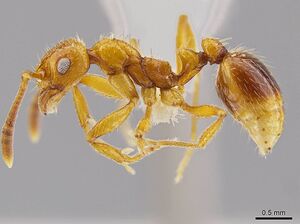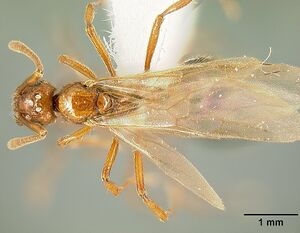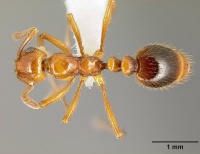Megalomyrmex adamsae
| Megalomyrmex adamsae | |
|---|---|

| |
| Scientific classification | |
| Kingdom: | Animalia |
| Phylum: | Arthropoda |
| Class: | Insecta |
| Order: | Hymenoptera |
| Family: | Formicidae |
| Subfamily: | Myrmicinae |
| Tribe: | Solenopsidini |
| Genus: | Megalomyrmex |
| Species group: | silvestrii |
| Species: | M. adamsae |
| Binomial name | |
| Megalomyrmex adamsae Longino, 2010 | |
Boudinot et al. (2013) - Megalomyrmex adamsae is an obligate xenobiont or guest ant social parasite, consuming fungus garden and host brood of fungus-growing ants (Adams, Shah et al. 2012). They are associates of at least two sympatric Mycetomoellerius sister species, Mycetomoellerius zeteki and Mycetomoellerius cf. zeteki in Panama (Adams, Jones et al. 2012; Adams, Shah et al. 2012; T. Schultz pers. comm.) which nest in creek embankments (Fernández-Marín et al. 2004). Parasite queens infiltrate newly founded colonies with few or no workers and a small garden. Remarkably, aggression between the queens subsides not long after infiltration and the host queen exhibits an obvious submissive posture (video). Male and female reproductives are produced at the start of the rainy season in Panama and 1–3 young queens are found in incipient host colonies from May to August. Reproductives were collected—in large numbers from one collection event, presumably from a flight—in September at Fort Clayton in Panama by R. Kimsey.
| At a Glance | • Xenobiotic |
Photo Gallery
 A Mycetomoellerius zeteki worker encounters a Megalomyrmex adamsae worker within her nest. Megalomyrmex adamsae lives in the fungus garden of Mycetomoellerius and preys selectively on its brood. Although a parasite within the nest, Megalomyrmex adamsae defends the garden from attack. Panama (captive colony at the University of Texas). Photo by Alex Wild.
A Mycetomoellerius zeteki worker encounters a Megalomyrmex adamsae worker within her nest. Megalomyrmex adamsae lives in the fungus garden of Mycetomoellerius and preys selectively on its brood. Although a parasite within the nest, Megalomyrmex adamsae defends the garden from attack. Panama (captive colony at the University of Texas). Photo by Alex Wild.
Identification
Boudinot et al. (2013) - Worker uniquely identified among Central American Megalomyrmex by the following combination: (1) katepisternum costate in dorsal third; (2) dorsal surface of mandible striate; (3) mandible usually with 6 teeth, basal teeth decreasing in size towards basal tooth; (4) meso- and metabasitarsi tubular; (5) occipital carina not visible in full-face view. Queen similarly identifiable as worker except most of katepisternum smooth, alate. Male recognized by the following: (1) scapes relatively long (SI > 80); (2) crossvein 1m-cu present; (3) postpetiolar sternum weakly convex; (4) setae on gastric tergum I coarse and relatively sparse.
The worker is distinguished from Megalomyrmex fungiraptor, in addition to having tubular basitarsi, by the following: (1) mandibles orange (vs. burgundy); (2) anterior margin of clypeus flattened, vertical, meeting dorsal face at an angle (vs. rounded); (3) scapes longer (SI 96–99 vs. 91–93); (4) macrosetae on funiculus appressed (vs. appressed to decumbent); (5) setae on temples, in full-face view, appressed to subdecumbent (vs. subdecumbent to suberect); (6) subpetiolar process stout; (7) postpetiolar helcium with crossribbing; (8) setae on body, but especially on first gastric tergum, more dilute; (9) setae stouter. For a list of characters separating males of M. adamsae from those of Megalomyrmex symmetochus see the latter species page. Generally, however, smaller males have less convex postpetiolar sterna, and more strongly bulging anterodorsal petiolar faces.
Keys including this Species
Distribution
sea-level to 100 m elevation
Latitudinal Distribution Pattern
Latitudinal Range: 9.16318° to 9.16°.
| North Temperate |
North Subtropical |
Tropical | South Subtropical |
South Temperate |
- Source: AntMaps
Distribution based on Regional Taxon Lists
Neotropical Region: Nicaragua, Panama (type locality).
Distribution based on AntMaps
Distribution based on AntWeb specimens
Check data from AntWeb
Countries Occupied
| Number of countries occupied by this species based on AntWiki Regional Taxon Lists. In general, fewer countries occupied indicates a narrower range, while more countries indicates a more widespread species. |

|
Estimated Abundance
| Relative abundance based on number of AntMaps records per species (this species within the purple bar). Fewer records (to the left) indicates a less abundant/encountered species while more records (to the right) indicates more abundant/encountered species. |

|
Biology
Longino (2010) - Megalomyrmex adamsae is a specialized predator of Attini, like its close relative Megalomyrmex symmetochus. Colonies cohabit nests with their attine hosts as "agro-predators," feeding on fungal mycelia and perhaps attine brood. Megalomyrmex adamsae and M. symmetochus differ in host preference: M. adamsae is typically found in Mycetomoellerius nests, M. symmetochus in Sericomyrmex nests (Adams, pers. comm.).
Megalomyrmex adamsae and M. symmetochus are very similar species. There is molecular evidence that the two are probably sister taxa (Adams, pers. comm.). The characters differentiating them in the diagnosis are consistent in Central America and the concordant molecular, morphological, and behavioral characters strongly support the existence of two sympatric species in central Panama.
I examined three collections from near Manaus, Brazil, and one collection from Peru that are in the symmetochus complex but do not cleanly fall into either adamsae or symmetochus. They vary in coarseness of pilosity and are somewhat in between the states of adamsae and symmetochus, the scape is long like symmetochus, the ventral petiolar keel is more like adamsae than symmetochus, they nest with Mycetomoellerius. Molecular evidence weakly alligns them with adamsae (Adams, pers. comm.).
Other South American examples of the symmetochus complex have been reported. Brown observed a colony from near Manaus, Brazil (reported as silvestrii in Kempf & Brown 1968; reidentified as symmetochus by Brandão 1990). He reported "The colony ... was found in a small rotten log in rain forest on 26.VIII.1962, in a small chamber with a small species of Mycetomoellerius. The ants of both species were found throughout the fungus garden of the chamber, but off to one side in a small chamber was found a group of the Mycetomoellerius clustered with a small piece of fungus garden unoccupied by Megalomyrmex. ... the situation suggested that the Megalomyrmex silvestrii colony had successfully attacked and moved into the attine nest, and was in the process of plundering it." Brandão (1990) reported a collection from Belem, PA, Brazil, from a nest of an unidentified Mycetomoellerius.
Castes
Worker
Images from AntWeb
   
| |
| Worker. Specimen code casent0630965. Photographer Brendon Boudinot, uploaded by University of Utah. | |
Queen
Images from AntWeb
   
| |
| Queen (alate/dealate). Specimen code casent0629669. Photographer Brendon Boudinot, uploaded by University of Utah. | |
   
| |
| Queen (alate/dealate). Specimen code usnment00693014. Photographer John T. Longino, uploaded by University of Utah. | Owned by USNM. |
Male
Images from AntWeb
    
| |
| Paratype Megalomyrmex adamsae. Male (alate). Specimen code casent0613259. Photographer John T. Longino, uploaded by University of Utah. | Owned by MCZ. |
Nomenclature
The following information is derived from Barry Bolton's Online Catalogue of the Ants of the World.
- adamsae. Megalomyrmex adamsae Longino, 2010: 41, figs. 3B, 3D, 7A–H (w.q.m.) PANAMA.
- Type-material: holotype worker, 8 paratype workers, 2 paratype queens, 2 paratype males.
- Type-locality: holotype Panama: Pipeline Rd, 4E heading N, 9.16000°N, 79.74490°W ±20 m., 50 m., 29.ix.1999, RMMA990929-01 (R. Adams); paratypes: 5 workers with same data, 3 workers, 2 queens, 2 males with same data but RMMA990929-06.
- Type-depositories: MCZC (holotype); CASC, MCZC, USNM (paratypes).
- Status as species: Boudinot, et al. 2013: 26.
- Distribution: Panama.
Unless otherwise noted the text for the remainder of this section is reported from the publication that includes the original description.
Description
Worker
(holotype): HW 0.846, HL 0.898, SL 0.885, EL 0.257, ML 1.287, CI 94, SI 99. (n=6): HW 0.816–0.895, HL 0.875–0.957, SL 0.851–0.918, EL 0.243–0.274, ML 1.287–1.391, CI 93–96, SI 96–99.
Palp formula 3,2; mandible generally with 6 teeth, apical largest, subapical next largest, 4 basal smallest and subequal in size (basal teeth vary from 4–6, and right and left mandible of same individual can vary in basal tooth number); dorsal surface of mandible coarsely striate; clypeus bulging; compound eye set in slight concavity of head capsule, most evident posterior to eye, ventral margin of concavity delimited by small carina (concavity and ventral carina of variable strength); occipital carina thin and not visible in full-face view; face and clypeus largely smooth and shining, with about 10 longitudinal linear carinulae on clypeus, coarse carinulae on malar space between compound eye and mandible, frontal carina fading into 2–3 longitudinal carinulae posteriorly, extending to about mid-length of compound eye, variable longitudinal etching elsewhere on face, 1–2 concentric carinulae around antennal fossa; ventral surface of head smooth and shining, anterior ends of occipital carina extend about 1/3 distance to hypostomal margin; mesosoma generally smooth and shiny; anepisternum, katepisternum, and lower sides of propodeum overlain with longitudinal carinulae (of variable strength on katepisternum); dorsal surface of propodeum concave; juncture of dorsal and posterior faces concave medially, forming blunt angles laterally; posterior face of propodeum with about 5 transverse carinulae; foraminal carina entire; dorsal petiole, postpetiole, and gaster smooth and shining, petiole and postpetiole with a few transverse posterodorsal carinulae; ventral keel of petiole in the form of a low translucent flange, forming a short angular tooth anteriorly, splitting and becoming two small subparallel carinulae posteriorly; posterolateral petiole with longitudinal carina, delimiting posteroventral concavity between lateral carina and ventral keel; ventral margin of postpetiole with short tooth; femora, tibiae, scapes, and dorsal surface of mandible covered with abundant subdecumbent setae; face, dorsal mesosoma, dorsal petiole and postpetiole with moderately abundant suberect coarse setae; dorsal gaster with dense suberect coarse setae; general body and appendage color orange, gaster darker, dorsal setae amber.
Queen
Measurements (n=3): HW 0.939–1.023, HL 0.929–0.950, SL 0.905–0.945, EL 0.336–0.341, ML 1.529–1.578, CI 101–108, SI 92–96.
Palp formula 3,2 or 4,3, with variable or partial fusion of terminal segments; general shape, sculpture, and pilosity characters, including mandibular dentition and sculpture, similar to worker; parapsidal lines barely visible; wing venation as in Fig. 7H.
Male
Boudinot et al. (2013) - Measurements (n=4, plus 1 from Longino 2010): HW 0.74–0.90, HL 0.72–0.89, SL 0.65–0.77, EL 0.42–0.53, ML 1.22–1.64, CI 101, SI 85, EI 56–60.
Head Antenna with 13 antennomeres; antennomere 3 apically kinked; apical antennomeres not forming a club; scape length greater than eye length. Scape yellowish-white; pedicel and antennomere 3 white; antennomeres 4–13 grading to honey yellow. Palpal formula 4,3. Mandible triangular, masticatory margin with 5 teeth; apical tooth largest; basal teeth decreasing in size from apical tooth. Dorsal face of mandible roughly striate. Minimum distance between lateral ocellus and compound eye less than to slightly more than one lateral ocellus length. Occipital carina not visible in full-face view. Mesosoma Mesosoma somewhat attenuate. Notauli absent. Parapsidal lines weak. Meso- and metabasitarsus not anteroposteriorly flattened. Metabasitarsus neither kinked nor swollen apically. Forewing crossvein 1m-cu present; submarginal cell 1 length about four times width; terminal abscissa of M branching from Rs distad 2r-rs. Pterostigma well-developed; longer posterad 2r-rs than anterad. Metasoma Ventrolateral longitudinal carina of petiole present. Postpetiolar helcium subcircular. Postpetiolar spiracle placed about midlength on lateral tergal margin on a lateral process. Sternum of postpetiole with a weak convexity in profile view. Postpetiolar tergum convex; not bilobed. Genitalia Abdominal sternum IX about as long as broad at base, triangular: lateral margins bulging about midlength and tapering to apex. Telomere short, triangular with narrowly rounded, angular apex; dorsal margin weakly concave, ventral margin weakly convex; dorsomedial dentiform process absent; medial face subrectangular; ventral margin without sclerotized denticle. Apical margin of cuspis slightly linear, tapering; apicodorsal angle more angular than apicoventral angle. Digitus stem narrow; apical blade broad, tapering strongly to apex; ventral margin weakly arched, becoming linear subapically; ventral margin not obscuring apicodorsal angle of cuspis. Valviceps about half as tall as long, subrectangular; apical (posterior) margin truncate; ventral margin weakly convex; penisvalvar teeth in anterior half truncate, posterior half acute; teeth close-set.
Type Material
Holotype worker, paratype workers, queens and male:PANAMA, Panamá: Pipeline Rd., 4E heading N, 9.16000°N 79.74490°W, ±20 m, 50 m, 29 Sep 1999 (R. Adams #RMMA990929-01) Museum of Comparative Zoology, California Academy of Sciences, National Museum of Natural History (holotype worker and paratype male examined, MCZ).
Etymology
This species is named for Rachelle Adams, whose extensive field and laboratory work has greatly advanced our understanding of the genus Megalomyrmex
References
- Adams, R.M.M., Liberti, J., Illum, A., Jones, T.H., Nash, D., Boomsma, J.J. 2013. Chemically armed mercenary ants protect fungus-farming societies. Proceedings of the National Academy of Sciences USA 110(39): 15752–15757 (doi:10.1073/pnas.1311654110).
- Adams, R.M.M., Mueller, U.G., Schultz, T.R., Norden, B. 2000. Agro-predation: usurpation of attine fungus gardens by Megalomyrmex ants. Naturwissenschaften 87:549–554.
- Adams, R.M.M., Shah, K., Antonov, L.D., Mueller, U.M. 2012. Fitness consequences of nest infiltration by the mutualist-exploiter Megalomyrmex adamsae. Ecological Entomology 37: 453–462 (doi:10.1111/j.1365-2311.2012.01384.x).
- Boudinot, B.E., Sumnicht, T.P. & Adams, R.M.M. 2013. Central American ants of the genus Megalomyrmex Forel (Hymenoptera: Formicidae): six new species and keys to workers and males. Zootaxa 3732, 1-82.
- Cardenas, C.R., Luo, A.R., Jones, T.H., Schultz, T.R., Adams, R.M.M. 2021. Using an integrative taxonomic approach to delimit a sibling species, Mycetomoellerius mikromelanos sp. nov. (Formicidae: Attini: Attina). PeerJ 9, e11622 (doi:10.7717/peerj.11622).
- Cardenas, C.R., Mularo, A.J., Chavez, A.S., Adams, R.M.M. 2022. Limited genetic differentiation of Mycetomoellerius mikromelanos in Parque National Soberanía, Panama: Implications for queen dispersal. Biotropica 00: 1-15 (doi:10.1111/btp.13171).
- de Bekker, C., Will, I., Das, B., Adams, R.M.M. 2018. The ants (Hymenoptera: Formicidae) and their parasites: effects of parasitic manipulations and host responses on ant behavioral ecology. Myrmecological News 28: 1-24 (doi:10.25849/myrmecol.news_028:001).
- Liberti, J., Sapountzis, P., Hansen, L.H., Sørensen, S.J., Adams, R.M.M., Boomsma, J.J. 2015. Bacterial symbiont sharing in Megalomyrmex social parasites and their fungus-growing ant hosts. Molecular Ecology 24, 3151–3169 (doi:10.1111/MEC.13216).
- Longino, J.T. 2010. A taxonomic review of the ant genus Megalomyrmex Forel in Central America. Zootaxa 2720: 35-58.
- Prado, L.P., Silva, R.R., Brandão, C.R.F., Morini, M.S.C., Adams, R.M.M. 2021. A natural history account of Megalomyrmex ayri Brandão, 1990 (Hymenoptera: Formicidae: Myrmicinae). Insectes Sociaux (doi:10.1007/s00040-021-00840-6).
- Sozanski, K., Prado, L.P., Mularo, A.J., Sadowski, V.A., Jones, T.H., Adams, R.M.M. 2020. Venom function of a new species of Megalomyrmex Forel, 1885 (Hymenoptera: Formicidae). Toxins 12, 679 (doi:10.3390/toxins12110679).
References based on Global Ant Biodiversity Informatics
- Boudinot B. E., T. P. Sumnicht, and R. M. M. Adams. 2013. Central American ants of the genus Megalomyrmex Forel (Hymenoptera: Formicidae): six new species and keys to workers and males. Zootaxa 3732(1): 1-82.
- Longino J. T. 2013. Ants of Nicargua. Consulted on 18 Jan 2013. https://sites.google.com/site/longinollama/reports/ants-of-nicaragua

